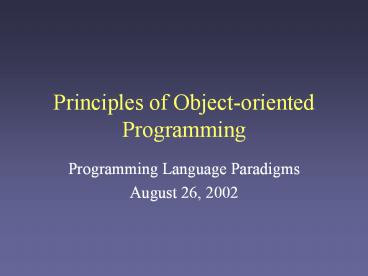Principles of Object-oriented Programming - PowerPoint PPT Presentation
1 / 15
Title:
Principles of Object-oriented Programming
Description:
Squeak compiler and VM written in Squeak. ... The Muppet class refers to the set of all muppets. ... This creates a class hierarchy in which subclasses take on ... – PowerPoint PPT presentation
Number of Views:336
Avg rating:3.0/5.0
Title: Principles of Object-oriented Programming
1
Principles of Object-oriented Programming
- Programming Language Paradigms
- August 26, 2002
2
Pre-history
- 40s/50s von Neumann architecture, stored
program concept - Allows the development of general-purpose
computing machines - Languages tend to be closely tied to the
underlying architecture - Structured programming emerges
- Verb and task oriented
- Difficult to scale
3
History
- Simula-67 objects, early GUI elements
- Xerox PARC (70s) Smalltalk, bitmap displays,
multiple windows, mouse, menus, icons, etc. - Smalltalk-80 modern version
- released outside PARC.
- Used a virtual machine and a bytecode compiler.
- Spinoff companies create commercial versions.
4
Squeak History
- 1995 (Apple) Alan Kay et al. create an
open-source version of Smalltalk. - Development of a platform that can be used by
people of all ages and skill levels. - Squeak compiler and VM written in Squeak.
- Support for sound, 2-D and 3-D graphics,
networking/web, Flash, etc.
5
Other OO history
- C developed at ATT labs (Stroustrup79)
- Interested in an efficient language that extended
C - Strong typing
- Objective C
- Used in NeXT and OS X combination of C and
Smalltalk. - Java developed by Sun (1991-1995)
- Initially developed as a language for
communicating appliances/set-tops - Modified for use with WWW.
- Smalltalk features in a typed environment
6
About Objects
- An object is a way to capture both the features
of a data structure and its behavior. - Noun-oriented encourages program design through
thinking about pieces - Construction of reusable elements
7
Classes and objects
- A class is a characterization of a type of
object. - The Muppet class refers to the set of all
muppets. - An object kermit is an instantiation of the
Muppet class. - Classes have
- Instance variables
- Class variables
- methods
8
An example
- Object subclass Muppet
- instanceVariableNames name
- classVariableNames numberOfSpecies
- category muppets
- To create a muppet
- Kermit lt- Muppet new.
9
Messages
- In Smalltalk, methods are invoked by sending the
object a message. - noun verb arg1 mod arg2 .
- Modeled on speech acts.
10
Inheritance
- One of the most popular OO features is
inheritance. - Can define new classes in terms of existing
classes. - This creates a class hierarchy in which
subclasses take on the behavior of their parent
classes. - A subclass can generate new behaviors by
- Defining new methods
- Overriding a parent method.
11
Inheritance example
12
Polymorphism
- Polymorphism is the idea that an object or method
can perform the same operation on different data
types. - Addition is polymorphic in most languages.
- Allows a programmer to write code without knowing
the types of the data involved. - listOfStuff sort lt- dont need to know what
this is a list of.
13
Polymorphism example
14
Encapsulation
- Encapsulation provides a way of packing all the
structure and behavior of an object into a single
module. - Interface the public face of an object
- Implementation How methods are carried out.
- Prevents users from misusing internal structure.
- Implementation can be changed without affecting
external programs.
15
Encapsulation example































